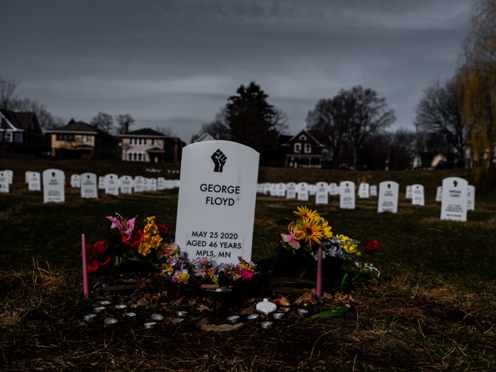Lessons from lynchings
By Charles M. Blow
There are many appalling narratives emerging from the trial of the former police officer Derek Chauvin in the killing of George Floyd.
There is the transference of guilt from the people who killed Floyd to those who watched him die. There is the difference in empathy when a Black person in the inner city is struggling with opioid addiction, compared to when the drug user is a young white person in a suburb or rural America.
But what resonated for me was the sense of powerlessness in Floyd begging, to no avail, for his life, and in the powerlessness of the agitated crowd of bystanders and witnesses to intervene. The power in this dynamic was held by the officers, including Chauvin, and it was wielded to a deadly extreme.
The application of force, a deadly force, even after Floyd was handcuffed, even after he became unresponsive, is to me emblematic of an attempt not only to punish Floyd’s body, but also to demonstrate complete control and demand complete submission. The treatment of Floyd’s body was a message to those in his community: Any perceived disorder or disobedience will be crushed, literally.
It recalled for me the long history of demonstrative displays against Black people in America. The enslavers performed barbaric acts on the bodies of so-called disobedient enslaved Africans, as a punishment to the person deemed guilty, but also as a deterrent to the fellow enslaved people who saw or heard of it.
It was the flaying of flesh, the human beings torn apart by hounds, the stiff bodies dangling from the stiff branch of a tree. The display was the thing. The theatrical production of pain, to the point of mutilation, was the thing. The transmission of trauma was the thing.
When the enslaved rebelled, this theatre was taken to even higher levels. The German Coast Uprising of 1811 in Louisiana, one of the largest slave revolts in US history, ultimately failed, but so intent were the white enslavers to terrorize the remaining enslaved never to repeat the attempt that, as Leon A. Waters wrote for the Zinn Education Project:
“Some of the leaders were captured, placed on trial and later executed. Their heads were cut off and placed on poles along the river in order to frighten and intimidate the other slaves. This display of heads placed on spikes stretched over 60 miles.”
When Nat Turner staged his revolt some 20 years later, the response took on a similar expression. As Daina Ramey Berry, an associate professor of history and African diaspora studies at the University of Texas at Austin, wrote for The New York Times in 2016 about Turner’s 1831 hanging:
“Those who came to witness his death then decapitated and skinned him. They bragged about it for decades. One participant, William Mallory, also known as Buck, gloated so much about having skinned Turner that it was listed in his own obituary.”
She wrote that one of her students even claimed that his family was in possession of a purse made from Turner’s skin.
Even after slavery ended, or maybe because it did, lynching surged. And the terror infliction moved from the plantation into the general populace. Often, the bodies weren’t just hanged, they were burned or their fingers, toes or genitalia sliced off. And to commemorate — and disseminate — the terror, postcards were often made of the lynchings.
In 1956, just months after being acquitted in the lynching of 14-year-old Emmett Till, his killers gave an interview to Look Magazine in which they confessed. As one of Till’s killers, J.W. Milam, said of the killing, “I just decided it was time a few people got put on notice” that as long as he lived Black people (he used a racial slur), “are gonna stay in their place.” As Milam is quoted as saying:
“I just made up my mind. ‘Chicago boy,’ I said, ‘I’m tired of ’em sending your kind down here to stir up trouble. Goddamn you, I’m going to make an example of you — just so everybody can know how me and my folks stand.’”
They pistol-whipped Till, made him strip naked on the banks of the Tallahatchie River that Sunday morning, shot him through the face, then tied a cotton gin to his neck with barbed wire, and pushed him in.
Till’s face would emerge nearly unrecognizable.
There is no way for me to know if Chauvin intended to kill Floyd, but there is an abundance of evidence of a depraved indifference about Floyd’s life. There is no way to predict how a jury will rule, even with video of the killing, and being predictive in that regard is not the point of this column.
My point is that there are echoes in Floyd’s killing, in public, in front of his community, in broad daylight, that reverberate from centuries of killings of men and women who look like Floyd, whose killings the system of the time validated or shielded.
It is hard not to draw the through-line from a noose on the neck to a knee on the neck. And it is also hard not to recall that few people were ever punished for lynchings.
Motionless Black bodies have been the tableau upon which the American story has unfolded, and Floyd’s body is sadly but one of the latest examples.
-New York Times


